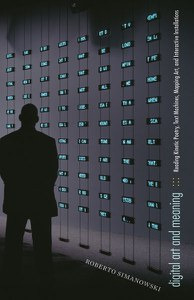Digital Art and Meaning: Reading Kinetic Poetry, Text Machines, Mapping Art, and Interactive Installations
From the publisher: How to interpret and critique digital arts, in theory and in practice Digital Art and Meaning offers close readings of varied examples from genres of digital art, including kinetic concrete poetry, computer-generated text, interactive installation, mapping art, and information sculpture. Roberto Simanowski combines these illuminating explanations with a theoretical discussion employing art philosophy and history to achieve a deeper understanding of each example of digital art and of the genre as a whole.
(Source: University of Minnesota Press catalog description)
It is important not to reduce any specific example of digital art to the status of typical representative of some aspect of digital media or of some genre of digital art. It is time to pay attention to the specificities of particular works.
...my agenda proceeds with a threefold rejection of the embrace: the embrace of code as such at the expense of its actual materialization, the embrace of the body's action at the expense of its cognitive reflection, and the embrace of the pure presence of the artwork at the expense of any examination of its semiotic meaning. What this book does embrace, however, is the methodology of close reading while rejecting its more traditional implications.
If the text continues to be important as a linguistic phenomenon, then we may speak of digital literature. If the text becomes primarily a visual object of interaction, then we are dealing with digital art.
This book is driven by the belief that the first purpose that a digital work serves is to produce an act of creative expression; it is not a mere product of technology or chance.
Works referenced:
- 1 of 2
- next ›
Critical writing referenced:
- 1 of 2
- next ›
Critical writing that references this:
Teaching Resource using this Critical Writing:
| Resource | Teaching Resource Type | Author | Year |
|---|---|---|---|
| Digital Genres: Digital Art, Electronic Literature, and Computer Games (DIKULT 103, Spring 2014) | Syllabus | Judd Morrissey, Álvaro Seiça | 2014 |


